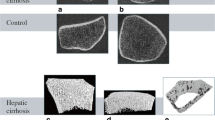Abstract:
Hepatic osteodystrophy is a complication of chronic liver disease and bone mass is known to decline further in the first year after liver transplantation. The present study focused on bone mineral density (BMD) between 1 and 15 years after liver transplantation under a prednisolone- and azathioprine-based immunosuppressive regimen. Three groups of adult patients were studied: group 1, 45 patients with a follow-up of 5–9 years after transplantation, had BMD measurements done at 1, 2 and 5 years after transplantation; group 2, 17 patients with a follow-up of 10–14 years, had BMD measurements done at 5 and 10 years; group 3, 4 patients with a follow-up of more than 15 years, had BMD measurements done at 10 and 15 years. BMD of lumbar spine (L1–L4) and proximal femur was measured using dual-energy X-ray absorptiometry, and at the same time radiographs of the spine and hips were made. Spinal BMD increased significantly, during the second post-transplant year; subsequently no significant changes were seen. Proximal femur BMD decreased slightly, but significantly during the second year, and remained stable afterwards. About one-third of patients had a BMD below the fracture threshold (= 0.798 g/cm2 for the lumbar spine and 0.675 g/cm2 for the hip) during the follow-up. In 5 of the 66 patients studied, new vertebral fractures occurred. No fractures or avascular necrosis of the hips were seen. Furthermore, after transplantation lower Z-scores of the hip were found in patients with pre-transplant cholestatic liver diseases, and lower Z-scores of the lumbar spine were found in men compared with women. Long-term follow-up of BMD up to 15 years after transplantation revealed an improvement mainly in the second postoperative year with no deterioration afterwards. Nevertheless a substantial number of patients (around one-third) kept a BMD below the fracture threshold, and new fractures may occasionally occur. The overall outcome appeared somewhat less favorable in men and patients transplanted for cholestatic liver diseases.
Similar content being viewed by others
Author information
Authors and Affiliations
Additional information
Received: 15 July 1999 / Accepted: 11 January 2000
Rights and permissions
About this article
Cite this article
Hamburg, S., Piers, D., van den Berg, A. et al. Bone Mineral Density in the Long Term after Liver Transplantation . Osteoporos Int 11, 600–606 (2000). https://doi.org/10.1007/s001980070081
Issue Date:
DOI: https://doi.org/10.1007/s001980070081




